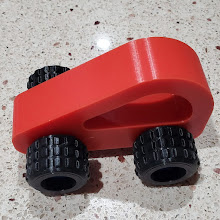If you decide to add a flash hider to a .223 rifle, it is best to use a guide for the die to keep it centered on the barrel when you cut the threads. Now, you can buy one for about $14 or you can make your own for two or three times that much. That is what I decided to do. The most expensive part was the 1/2X28 die. I also bought a 1/2X28 tap in case I want to design and make my own flash hider/recoil reducer. The next expense is the steel rod. I used a ½ inch and a ¼ inch rod to make the guide. I already had a lathe, files, threading tool for the lathe, turning tool, cut off tool, hack saw, center drills, micrometer, dial micrometer, cutting fluid, oil – the usual stuff.
Since the 1/2X28 die is 1.5 inches in diameter, I found I did not have a die holder, so I learned how to thread the ½ inch rod using a threading tool. To do that the gears of the lathe must be changed. Once I figured out how to do that, the rest was patience and measuring.
With the threaded rod in the lathe, I put the drill chuck in the tail stock and center drilled the rod, then used a home made tap guide held in that drill chuck to tap the ½ inch rod 10-32.
Setting aside the ½ inch rod, I took a ¼ inch rod, cut off a piece, put it in the lathe, squared the end, center drilled it for a live center held in the tail stock, and proceeded to turn it to .218 inches for the bore of the rifle to have the barrel threaded. Slow and steady with much measuring is the way to go. I found the Starret micrometer more accurate than the dial micrometer. When it read .218, it was time to cut off the distal end and thread it 10-32 using a die guide for the tail stock of the lathe. At that point I learned the rod was too big to thread as it was so I reduced one end to .197 using the turning tool and threaded that portion on the lathe. It is very easy to line things up by using the tail stock and the head chuck. After I finished threading the .218 rod I discovered the big challenge in threading was because I put the die in backwards and had no starting taper to speak of.
After threading the .218 rod, I cut off the near end, checked to make sure it screwed into the ½ inch rod, removed it and set it aside, then cut off the threaded portion of the ½ inch rod. A file was used to round a few edges to start the post and the die easily. The two threaded steel pieces were assembled and it was done. J
Tractor Boy







